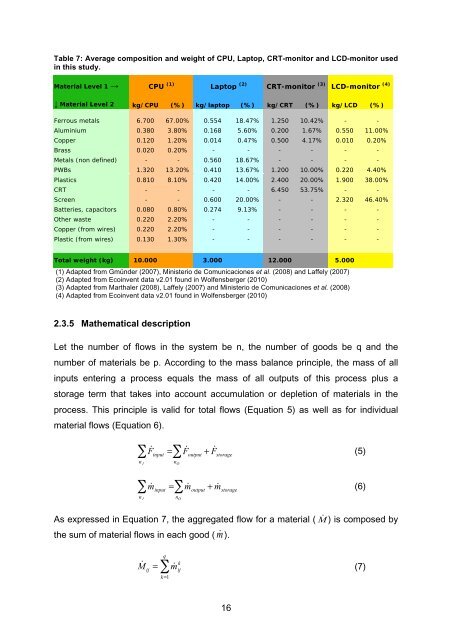10 07 29 Master thesis Juliana Leon - e-Waste. This guide
10 07 29 Master thesis Juliana Leon - e-Waste. This guide
10 07 29 Master thesis Juliana Leon - e-Waste. This guide
Create successful ePaper yourself
Turn your PDF publications into a flip-book with our unique Google optimized e-Paper software.
Table 7: Average composition and weight of CPU, Laptop, CRT-monitor and LCD-monitor used<br />
in this study.<br />
Material Level 1 → CPU (1) Laptop (2) CRT-monitor (3) LCD-monitor (4)<br />
↓ Material Level 2 kg/CPU (%) kg/laptop (%) kg/CRT (%) kg/LCD (%)<br />
Ferrous metals 6.700 67.00% 0.554 18.47% 1.250 <strong>10</strong>.42% - -<br />
Aluminium 0.380 3.80% 0.168 5.60% 0.200 1.67% 0.550 11.00%<br />
Copper 0.120 1.20% 0.014 0.47% 0.500 4.17% 0.0<strong>10</strong> 0.20%<br />
Brass 0.020 0.20% - - - - - -<br />
Metals (non defined) - - 0.560 18.67% - - - -<br />
PWBs 1.320 13.20% 0.4<strong>10</strong> 13.67% 1.200 <strong>10</strong>.00% 0.220 4.40%<br />
Plastics 0.8<strong>10</strong> 8.<strong>10</strong>% 0.420 14.00% 2.400 20.00% 1.900 38.00%<br />
CRT - - - - 6.450 53.75% - -<br />
Screen - - 0.600 20.00% - - 2.320 46.40%<br />
Batteries, capacitors 0.080 0.80% 0.274 9.13% - - - -<br />
Other waste 0.220 2.20% - - - - - -<br />
Copper (from wires) 0.220 2.20% - - - - - -<br />
Plastic (from wires) 0.130 1.30% - - - - - -<br />
Total weight (kg) <strong>10</strong>.000 3.000 12.000 5.000<br />
(1) Adapted from Gmünder (20<strong>07</strong>), Ministerio de Comunicaciones et al. (2008) and Laffely (20<strong>07</strong>)<br />
(2) Adapted from Ecoinvent data v2.01 found in Wolfensberger (20<strong>10</strong>)<br />
(3) Adapted from Marthaler (2008), Laffely (20<strong>07</strong>) and Ministerio de Comunicaciones et al. (2008)<br />
(4) Adapted from Ecoinvent data v2.01 found in Wolfensberger (20<strong>10</strong>)<br />
2.3.5 Mathematical description<br />
Let the number of flows in the system be n, the number of goods be q and the<br />
number of materials be p. According to the mass balance principle, the mass of all<br />
inputs entering a process equals the mass of all outputs of this process plus a<br />
storage term that takes into account accumulation or depletion of materials in the<br />
process. <strong>This</strong> principle is valid for total flows (Equation 5) as well as for individual<br />
material flows (Equation 6).<br />
∑<br />
n I<br />
F ˙<br />
input<br />
=<br />
∑ F ˙<br />
output<br />
+ F ˙<br />
storage<br />
(5)<br />
n O<br />
€<br />
∑<br />
n I<br />
m ˙ input<br />
=<br />
∑ m ˙ output<br />
+ m ˙ storage<br />
(6)<br />
n O<br />
As expressed in Equation 7, the aggregated flow for a material ( M ˙ ) is composed by<br />
the sum of material € flows in each good ( m ˙ ).<br />
q<br />
€<br />
M ˙<br />
k<br />
ij<br />
= ∑ m ˙ ij (7)<br />
k =1<br />
€<br />
€<br />
16
















